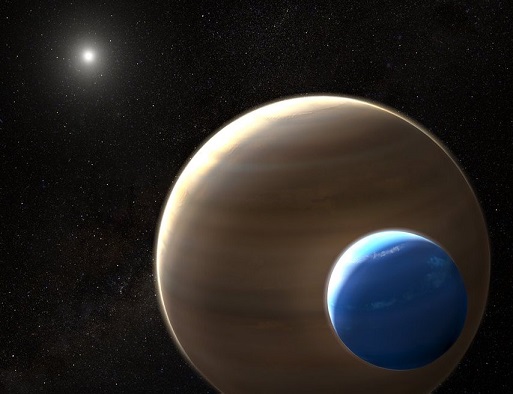
Hubble and Kepler space telescopes have found compelling evidence for a moon outside the Solar System. The data indicate an exomoon the size of Neptune, in a stellar system 8000 light-years from Earth. Image: NASA/Twitter
NEW YORK (PTI): Astronomers using Hubble and Kepler space telescopes have found compelling evidence for the existence of the first known moon outside our solar system, orbiting a gas-giant planet 8,000 light-years away.
According to the finding published in the journal Science Advances, the candidate exomoon – moons orbiting planets in other star systems – is unusual because of its large size, comparable to the diameter of Neptune.
Such gargantuan moons do not exist in our own solar system, where nearly 200 natural satellites have been catalogued, said researchers from the Columbia University in the US.
"This would be the first case of detecting a moon outside our solar system," said David Kipping, an assistant professor of astronomy at Columbia University.
"If confirmed by follow-up Hubble observations, the finding could provide vital clues about the development of planetary systems and may cause experts to revisit theories of how moons form around planets," Kipping said.
In looking for exomoons, the researchers analysed data from 284 Kepler-discovered planets that were in comparatively wide orbits, with periods greater than 30 days, around their host star.
The observations measured the momentary dimming of starlight as a planet passed in front of its star, called a transit.
The researchers found one instance, in Kepler 1625b, that had intriguing anomalies.
"We saw little deviations and wobbles in the light curve that caught our attention," Kipping said.
The Kepler results were enough for the team to get 40 hours of time with Hubble Telescope to intensively study the planet, obtaining data four times more precise than that of Kepler.
The researchers monitored the planet before and during its 19-hour-long transit across the face of the star.
After it ended, Hubble detected a second and much smaller decrease in the star's brightness 3.5 hours later, consistent with "a moon trailing the planet like a dog following its owner on a leash," Kipping said.
"Unfortunately, the scheduled Hubble observations ended before the complete transit of the moon could be measured," Kipping said.
In addition to this dip in light, Hubble provided supporting evidence for the moon hypothesis by measuring that the planet began its transit 1.25 hours earlier than predicted.
This is consistent with the planet and moon orbiting a common centre of gravity (barycentre) that would cause the planet to wobble from its predicted location.
"An extraterrestrial civilisation watching the Earth and Moon transit the Sun would note similar anomalies in the timing of Earth's transit," Kipping said.
The researchers note that in principle this anomaly could be caused by the gravitational pull of a hypothetical second planet in the system, although Kepler found no evidence for additional planets around the star during its four-year mission.
"A companion moon is the simplest and most natural explanation for the second dip in the light curve and the orbit-timing deviation," said Alex Teachey, Graduate Fellow in astronomy at the Columbia University.
The moon is estimated to be only 1.5 per cent the mass of its companion planet, which itself estimated to be several times the mass of Jupiter. This value is close to the mass-ratio between the Earth and its moon.
However, in the case of the Earth-Moon system and the Pluto-Charon system –the largest of the five known natural satellites of the dwarf planet Pluto – an early collision with a larger body is hypothesised to have blasted off material that later coalesced into a moon.
Kepler 1625b and its satellite, however, are gaseous, not rocky, and, therefore, such a collision may not lead to the condensation of a satellite.
Exomoons are difficult to find because they are smaller than their companion planet and so their transit signal is weak; they also shift position with each transit because the moon is orbiting the planet, researchers said.
In addition, the ideal candidate planets hosting moons are in large orbits, with long and infrequent transit times. In this search, the Neptune-sized moon would have been among the easiest to first detect because of its large size, they said.
 Previous Article
Previous Article Next Article
Next Article













The Indian Air Force, in its flight trials evaluation report submitted before the Defence Ministry l..
view articleAn insight into the Medium Multi-Role Combat Aircraft competition...
view articleSky enthusiasts can now spot the International Space Station (ISS) commanded by Indian-American astr..
view article